Building a strong customer loyalty ladder is crucial for any business looking to increase customer retention rate, increase customer lifetime value, and turn loyal customers into brand advocates. But let's face it, persuading customers to climb that ladder and develop a deep emotional connection with your brand is no easy feat.
It requires a strategic approach, a keen understanding of customer needs, and a commitment to delivering exceptional experiences at every stage of the customer journey.
In this blog post, I'll share my insights on how to create a customer loyalty ladder that not only attracts new customers but also develop long-term relationships with your existing ones.
We'll dive into the key stages of the ladder, explore strategies for moving customers up each rung, and discuss how to leverage customer feedback and data to continuously improve your approach.
Whether you're a seasoned marketer or just starting to focus on customer loyalty, this post will provide you with actionable tips and real-world examples to help you build a loyal customer base that drives business growth.
Contents:
-
First Rung Strategies: Moving Consumers (Suspects - Unengaged) to Leads
-
Third Rung Strategies: Moving Prospects to Customers (First Time Buyers)
-
Fourth Rung Strategies: Moving Customers (First Time Buyers) to Clients (Repeat Buyers)
-
Fifth Rung Strategies: Moving Clients (Repeat Buyers) to Brand Advocates
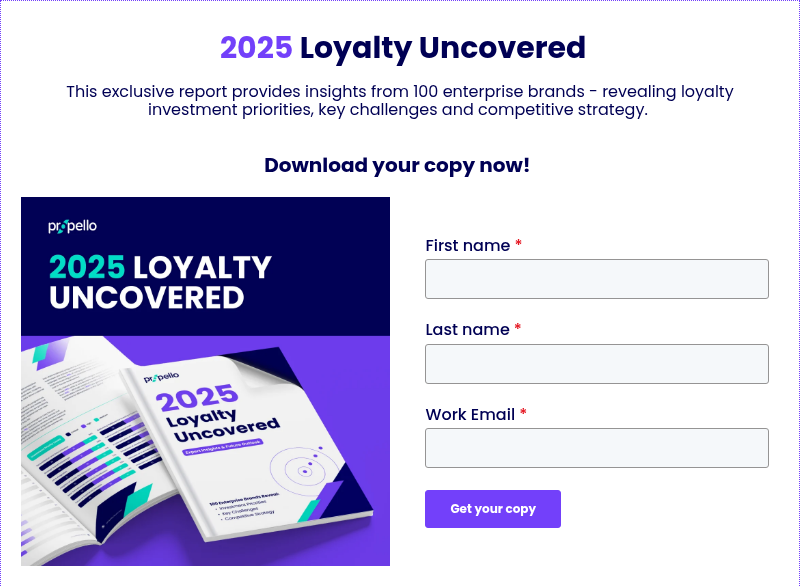
Key takeaways
-
A customer loyalty ladder is a powerful framework for building deeper, more meaningful relationships with customers at every stage of their journey.
-
Understanding the emotions, motivations, and mindsets that drive customer behaviour at each loyalty level is crucial for creating effective strategies.
-
Segmenting customers based on their level of engagement and loyalty allows for targeted, personalised experiences that resonate with each group's unique needs and preferences.
-
Implementing the right strategies at each rung of the ladder, from lead generation to advocacy, is essential for guiding customers toward deeper levels of engagement and loyalty.
-
A data-driven approach to customer loyalty, combined with a focus on delivering exceptional experiences, can help businesses boost retention, drive advocacy, increase customer lifetime value, and reduce acquisition costs.
-
Encouraging and rewarding customer referrals, user-generated content, and social media engagement can harness the power of brand advocates and word-of-mouth marketing.
-
Continuously seeking customer feedback, anticipating their needs, and using insights to drive improvements is key to fostering long-term, mutually beneficial relationships that drive business growth.
What is a Customer Loyalty Ladder?
Imagine your customer loyalty ladder as a framework for building deeper, more meaningful relationships with your customers. It's all about putting yourself in their shoes, understanding what they need at each stage of their journey, and delivering experiences that keep them coming back for more.
Picture a ladder with six rungs, each representing a different level of customer loyalty. As customers interact with your brand, they move up or down the ladder, depending on how well you meet their needs and expectations.
There's no one-size-fits-all approach to naming these rungs. Some marketers might call them "suspects," "leads","prospects," "customers," "clients," and "advocates." Others might use terms like "leads," "supporters," or "brand ambassadors." The specific labels aren't what matters most – what's important is that you're able to clearly define and differentiate each loyalty level of the customer journey.

Loyalty Levels and their Actions
Here's how I like to break them down:
Brand Advocates: These are your brand's biggest champions – the ones who shout your praises from the rooftops and refer you to their friends, family, and followers through word-of-mouth, online reviews, and referral programmes.
Clients (or repeat customers): Loyal customers who regularly engage with your brand, make repeat purchases, and are more receptive to upsells and cross-sells. Clients have developed a strong trust in your brand, which is the reason why they’re comfortable trying new offerings and making repeat purchases.
Customers (first time): At this stage, individuals have made their first purchase and taken a chance with your brand. They’re evaluating their experience and deciding whether to stick with you or explore other options. It’s likely they’re still in the consideration stage with competitors. But they’ve still made that first crucial step towards building a lasting relationship. It’s up you to make a lasting impression here.
Prospects: Potential customers who are actively considering whether to buy from you or your competitors, these individuals are actively researching and considering their options. They’re engaged in the buying process but haven’t yet made a purchase. They’re looking for information, comparing alternatives, and weighing the pros and cons of different solutions.
Leads: leads are Individuals who have expressed some level of interest in your product or service. They may have engaged with your brand through various touchpoints, such as visiting your website, signing up for your email list, or following you on social media. They’re aware of your offerings but haven’t yet entered the consideration stage.
Consumer (suspects - unengaged):
At the bottom of the ladder, a Suspect refers to a potential customer who fits your target market profile but has not yet interacted with your company. Suspects are individuals or businesses that could benefit from your company's products or services based on their characteristics, such as demographics or psychographics.
The goal is to guide every person who interacts with your brand up the ladder, turning leads into prospects, prospects into customers, customer, client and eventually advocate. When you:
-
Deliver personalised experiences
-
Anticipate your customers’ needs
-
Consistently exceed their expectations
You'll eventually move them up to the next rung of the customer loyalty ladder. Each rung represents a stage in your relationship marketing efforts.
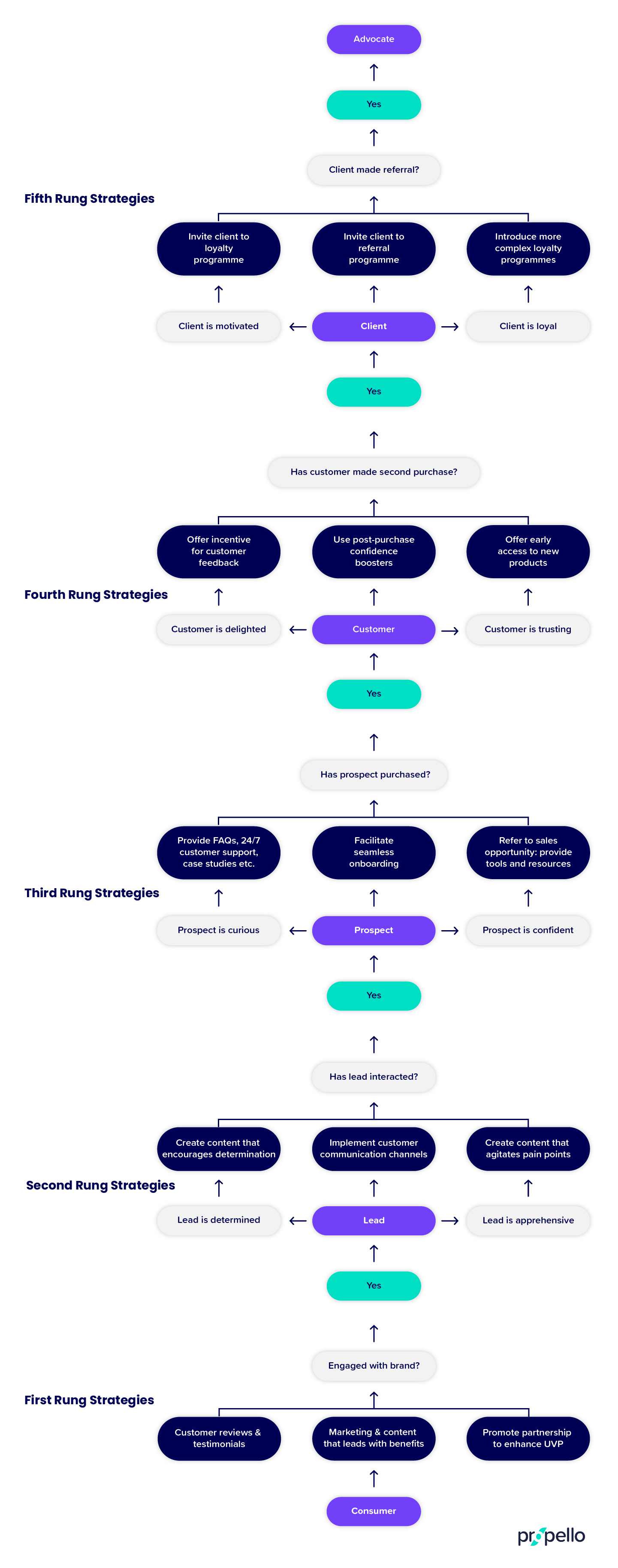
Why is a Customer Loyalty Ladder Important?
In today's hyper-competitive market, simply offering a great product or service is no longer enough to win customers' hearts and minds. With countless options at their fingertips, consumers are more discerning than ever – they want brands that not only meet their needs but also values their loyalty and goes above and beyond to create meaningful, personalised experiences.
That's where the customer loyalty ladder comes in. Think of the possibilities by just segmenting customers based on their level of engagement and loyalty. You can craft targeted strategies that resonate with each group's unique needs and preferences. It's about meeting them where they are in their journey and providing the right mix of communication, content, and rewards to keep them moving up that all-important ladder.
Think about it this way: a one-size-fits-all approach to customer loyalty is like trying to climb a ladder with missing rungs. You might make some progress, but without a clear path to the top, you're likely to get stuck or lose your footing altogether. A well-defined customer loyalty ladder, on the other hand, provides a sturdy framework for building lasting relationships with your customers.
Benefits of a Customer Loyalty Ladder
When executed effectively, a customer loyalty ladder can help you:
1) Boost customer retention:
By providing tailored experiences and rewards that align with customers' evolving needs, you'll keep them coming back for more.
2) Drive brand advocacy:
As customers move up the ladder, they become more than just loyal purchasers – they become passionate brand advocates who spread the word about your business. Consider this:
92% of consumers trust recommendations from friends and family over any other form of advertising.
3) Increase customer lifetime value:
Loyal customers aren't just more likely to stick around – they're also more valuable to your bottom line. On average, loyal customers are worth up to 10 times as much as their first purchase.
4) Reduce acquisition costs:
Acquiring new customers is more often than not more expensive than retaining them. A simple switch in focus, nurturing customer loyalty instead of too much focus on attracting cold leads, is a tried, tested and proven method of reducing churn. Not to mention the need for costly acquisition campaigns.
But here's the kicker: to reap these benefits, you need a data-driven approach to customer loyalty. Your loyalty ladder is the framework in which insights about your customers can be gleaned. You can identify high-value segments, predict churn risk, and optimise your strategies for maximum impact. It's about working smarter, not harder – and putting your customers at the centre of everything you do.
The Stages of the Customer Loyalty Ladder
To really understand your customers and create a loyalty ladder that resonates, you need to dive deep into their psyche at each stage of their journey. It's not just about the actions they take – it's about the emotions, motivations, and mindsets that drive those actions. Let's take a closer look at the key traits and conditions that define each rung of the ladder:
| Stage | Condition | Situational Trait |
| Consumer (Suspect) | Potential need | Brand unaware |
| Lead | Desirous | Observant |
| Prospect | Apprehensive | Determined |
| Customer (First Time Buyer) | Curious | Confident |
| Client (Repeat Buyer) | Delighted | Trusting |
| Advocacy | Motivated | Loyal |
At first glance, these might seem similar to the classic stages of the customer buying journey – awareness, consideration, purchase, retention, advocacy. But there's a crucial difference: the loyalty ladder goes beyond surface-level actions to uncover the deeper psychological states that drive customer behaviour.
Think about it this way:
-
Consumers (Suspects) Potential need: Although Suspects have not shown interest, they may have a potential need or desire that your company's products or services could fulfil. They are not familiar with your brand and may not even know that it exists. They have not had any exposure your marketing messages or offerings.
-
Leads in the awareness stage aren't just passively absorbing information – they're observant and driven by a desire to solve a problem or meet a need.
-
Prospects in the consideration stage aren't just weighing their options – they're grappling with apprehension and determination as they seek to make the right choice.
-
Customers (First time buyer) who have made a purchase aren't just satisfied with their decision – they're curious to see how your product or service will meet their needs, and confident that they've made the right choice.
-
Clients (Repeat Buyers)in the retention stage aren't just happy customers – they're delighted by their experience and growing more trusting of your brand with each interaction.
-
Advocates at the top of the ladder aren't just loyal purchasers – they're motivated by a deep emotional connection to your brand and eager to share their passion with others.
With a grip on these nuances you can craft a customer loyalty strategy that goes beyond surface-level tactics and creates meaningful, lasting relationships with your customers. It's about tapping into their deepest needs and desires, and delivering experiences that exceed their expectations at every turn.
Avoid settling for a loyalty ladder that just scratches the surface. Dig deep, get to know your customers inside and out, and they will climb higher and higher toward brand advocacy.
Why Knowing Where to Implement Strategies is Crucial
The difference between prospects and the rest of the levels is that the latter each involve a form of transaction. Customers and clients make purchases, as do advocates but they also transact referrals.
But without a referral programme in place, a dedicated following or an influencer on side, much of your customer acquisition boils down to the quality of your marketing. The strength of your sales and how well you qualify leads is also vital at this stage.
A loyalty ladder can help you refine both your marketing and sales approach. It’ll help you identify which customers are more likely to convert into advocates, allowing you to invest time and resources accordingly.
You don’t want to waste your customers’ time by bugging them for referrals. Equally, you want to correctly identify clients who may need a little push towards advocacy.
We do this by applying the right strategies at every level of loyalty.
Strategies for each rung
To create an effective customer loyalty ladder, it's not enough to just have a set of strategies – you need to know exactly where and when to deploy them for maximum impact. With the right strategy at the right stage of the customer journey, you can more effectively guide individuals toward deeper levels of engagement and advocacy.
One key difference between the loyalty ladder and the traditional buyer's journey is the nature of the customer's relationship with your brand. While the buyer's journey focuses primarily on the path to purchase, the loyalty ladder recognises that the customer's engagement doesn't end with a single transaction.
In fact, the real work of building loyalty often begins after that first sale. That's why it's so important to have a clear understanding of the specific actions, emotions, and motivations that characterise each rung of the ladder.
Here’s our table:
| Condition | Situational Trait | Action | Loyalty Stage |
| Potential need | Brand unaware | Unengaged - unaware of your brand |
Consumer (Suspect) |
| Desirous | Observant | Engaged with your brand |
Lead |
| Apprehensive | Determined | Interacted with your brand | Prospect |
| Curious | Confident | Purchased your product |
Customer |
| Delighted | Trusting | Made repeat purchases & bought your other products | Client |
| Motivated | Loyal | Referred another customer to you | Advocate |
Before we focus on “which” strategies to use, we should first work out “where” to use them. The strategies we’ll use will actually be the rungs of the ladder.
First Rung Strategies of the Customer Loyalty Ladder: Moving Consumers (Suspects - Unengaged) to Leads
Generating and attracting leads
Want to get more leads engaging with your brand? Start by showcasing your value through customer reviews, testimonials, and strategic partnerships. Consumer trust is at an all-time low. That’s why it’s important to substantiate the quality of your service or product.
For further information see our article for Ultimate Guide: Top 19 Customer Acquisition Channels Analysed which include some of the following:
Targeted advertising:
-
Develop targeted advertising campaigns that focus on the specific demographics, interests, and behaviours of your Suspects.
-
Utilise various advertising channels, such as social media, display ads, and search engine marketing, to reach your target audience effectively.
Content marketing:
-
Create valuable, informative, and engaging content that addresses the needs, pain points, and interests of your Suspects.
-
Distribute this content through various channels, such as blog posts, videos, infographics, to attract and educate potential customers.
Social media engagement:
-
Establish a strong presence on social media platforms that your Suspects are likely to use.
-
Share relevant content, engage with your audience, and participate in industry conversations to build brand awareness and credibility.
Partnerships and collaborations:
-
Seek out strategic partnerships or collaborations with complementary brands or organisations that share your target audience.
-
Cross-promote each other's products or services, or create joint marketing campaigns to expand your reach and attract new Leads.
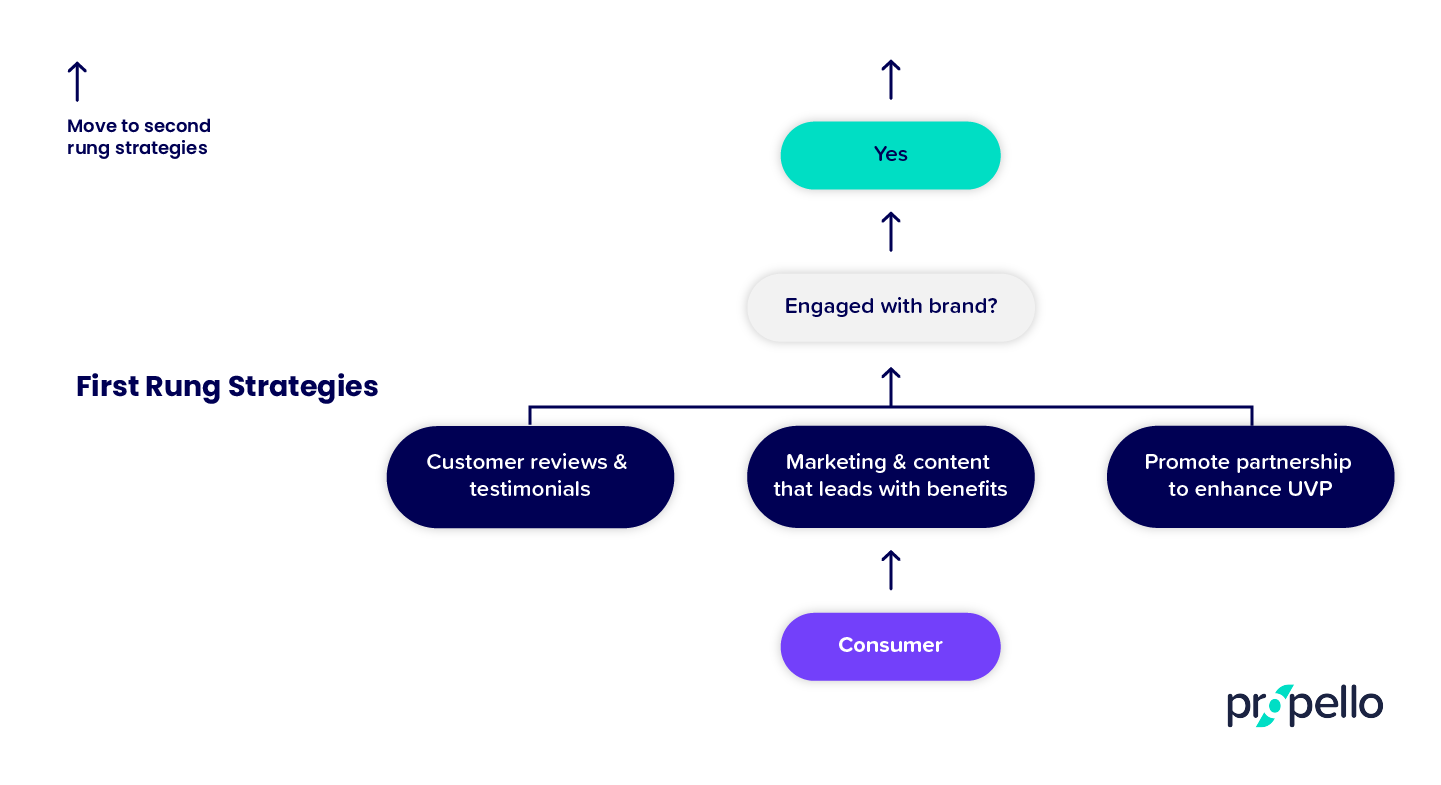
Second Rung Strategies of the Customer Loyalty Ladder: Moving Leads to Prospects
Strategies for connecting with prospects
At this stage, prospects may feel either apprehensive or determined. We recommend our clients to give prospects content that addresses pain points and encourages them to take action.
Customer Communication Channels
-
Don't forget to provide easy ways for them to connect with you, like chat bots or social media channels to make the purchase decision straight forward.
Lead nurturing with targeted content:
-
Develop targeted email campaigns that provide valuable content, product information, and special offers to nurture Leads and guide them towards a purchase decision.
-
Segment your Leads based on their interests, behaviour, or stage in the buyer's journey to deliver personalised and relevant content.
Free trials or samples:
-
Offer free trials, samples, or demonstrations of your products or services to allow Leads to experience their value firsthand.
-
This strategy helps build trust, reduces perceived risk, and encourages Leads to consider making a purchase.
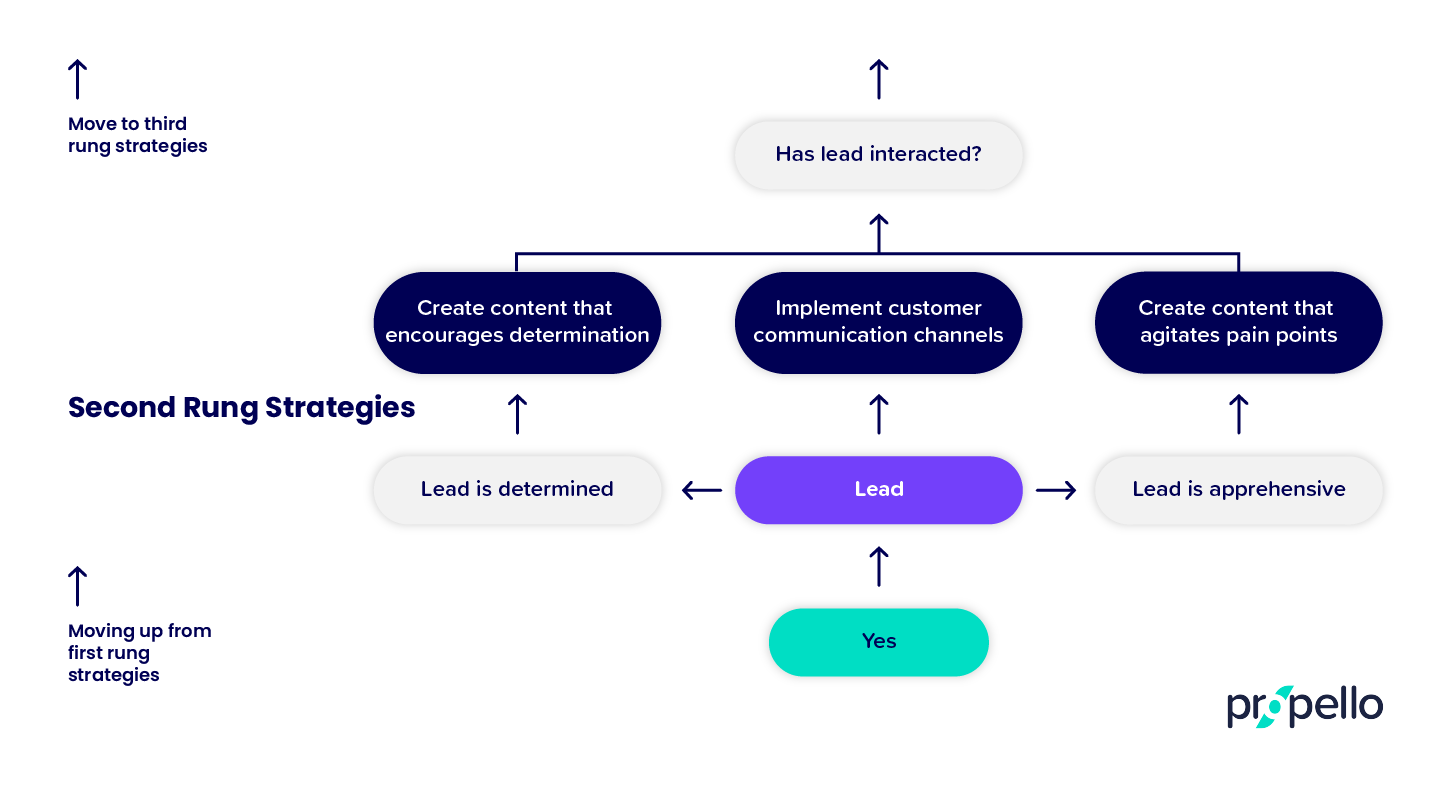
Third Rung Strategies of the Customer Loyalty Ladder: Moving Prospects to Customers (First Time Buyers)
Turning prospects into customers
Once a prospect is ready to buy, your job is to make the process as smooth as possible. A seamless onboarding experience is key to turning prospects into happy customers.
-
Anticipate their questions and concerns, and have answers ready to go.
-
The more confident they feel about their decision, the more likely they are to stick with you for the long haul.
-
Brand tone is vital here too! We always recommend using an agreeable tone as the foundation for your brand’s voice.
Strategies for enhancing the customer experience
You’ve won their business but the real work is just beginning. To keep customers coming back, you need to consistently deliver exceptional experiences that leave them feeling valued and appreciated.
-
Use post-purchase confidence boosters to reinforce their decision and build trust.
-
Reward their loyalty with personalised touches and exclusive perks.
-
Always keep the lines of communication open, regularly seeking feedback and showing that you’re listening enhances your brand reputation.
-
Offer them an omnichannel experience.
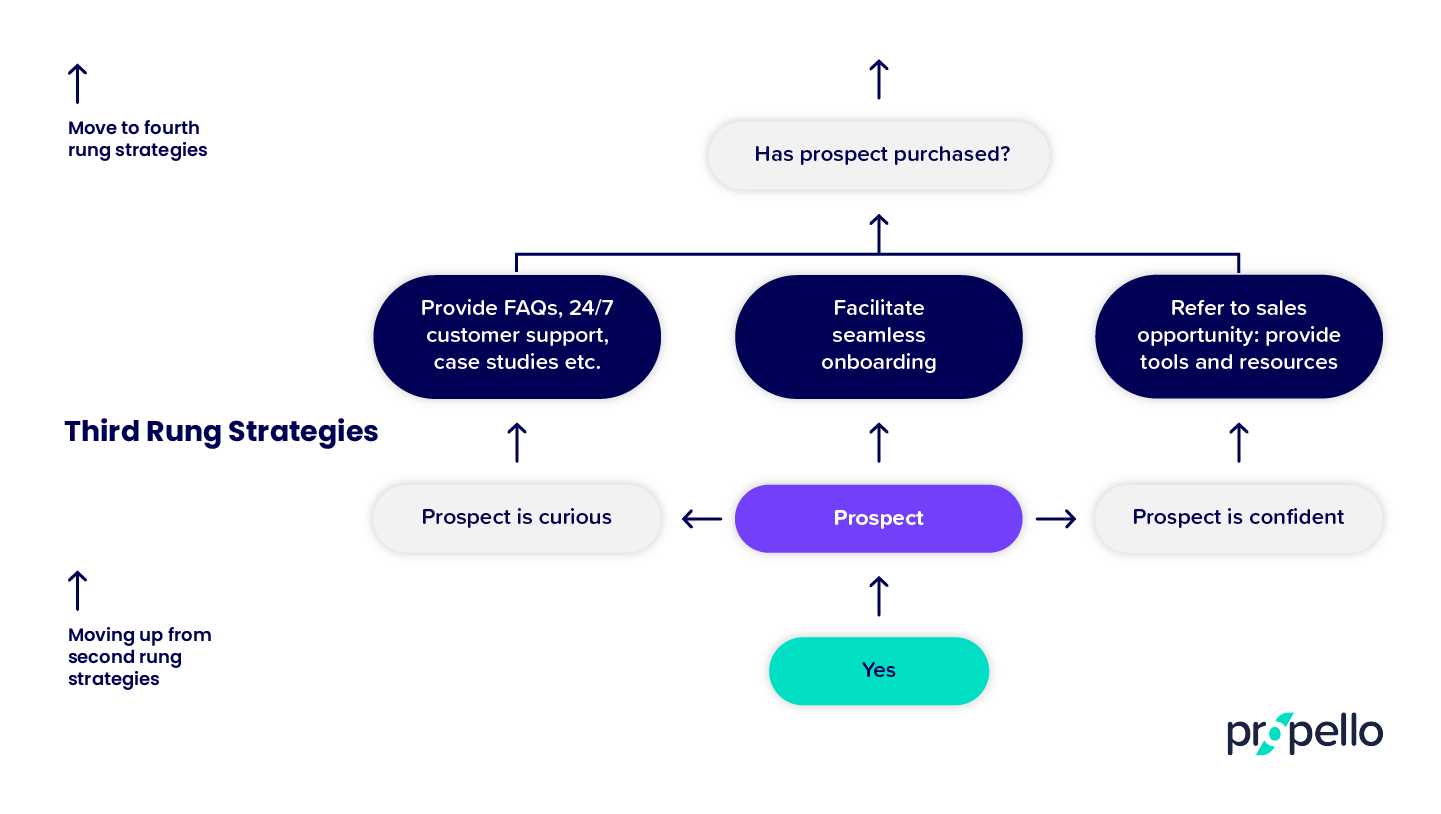
Fourth Rung Strategies of the Customer Loyalty Ladder: Moving Customers (First Time Buyers) to Clients (Repeat Buyers)
Retaining customers and building loyalty
Transforming one-time customers into loyal clients is all about going above and beyond. Anticipate their needs, solve their problems, and make them feel like a valued part of your community.
-
Offer exclusive access to events, content, or products that align with their interest.
-
When they share feedback, listen carefully and use it to drive continuous improvement.
Strategies for improving customer satisfaction and engagement
As your relationships with clients deepen, so should your engagement strategies.
-
Consider implementing a tiered customer loyalty programme that rewards repeat purchases and encourages them to move up the ladder.
-
Gamification can be a powerful tool for boosting engagement and making the experience more interactive and fun.
-
Get creative with your rewards! Offer personalised discounts, exclusive experiences, or even charitable donations that align with their values.
- Hyper-relevant rewards from closely aligned brand partners can be featured on your loyalty and reward programme to provide additional value.
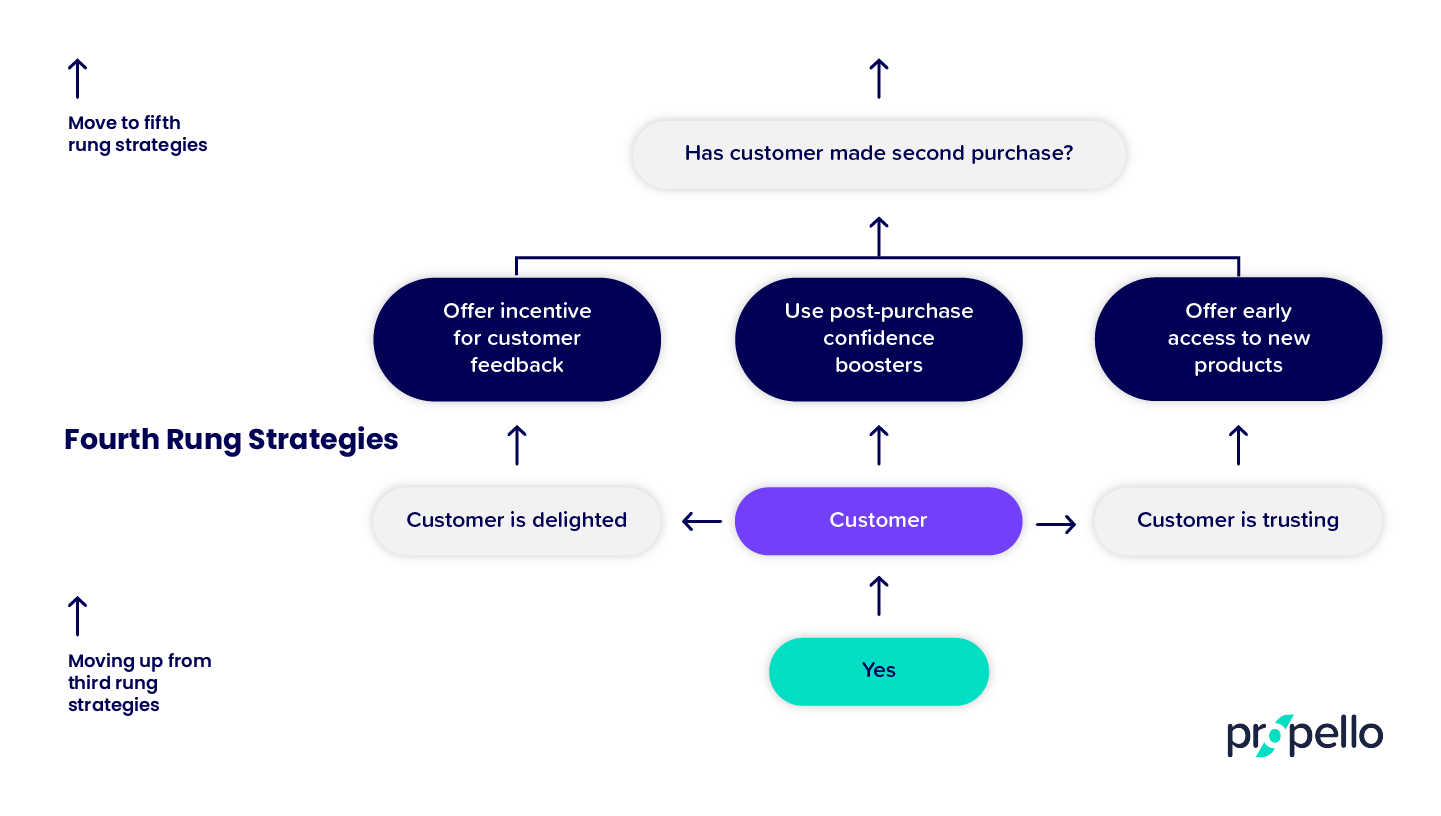
Fifth Rung of the Customer Loyalty Ladder: Moving Clients (Repeat Buyers) to Brand Advocates
Inspiring advocacy among clients
Advocates are your ultimate goal - the loyal customers who recommend your brand to others. To turn clients (or repeat purchasers) into advocates, focus on delivering truly exceptional experiences that they can’t help but rave about.
-
Give them a behind-the-scenes look at your brand, invite them to beta test new products, or seek their input on upcoming releases.
-
Make them feel like valued insiders and watch as they become your biggest champions.
Harnessing the power of brand advocates and word-of-mouth marketing
Once you’ve identified advocates using a CRM or loyalty programme, make it easy for them to spread the word. A referral programme that rewards them for bringing in new business is a great place to start.
-
Encourage them to leave reviews, share their experiences on social media, and provide user-generated content.
-
Always remember to show your appreciation with personalised thank yous and exclusive perks that demonstrate how much you value their loyalty.
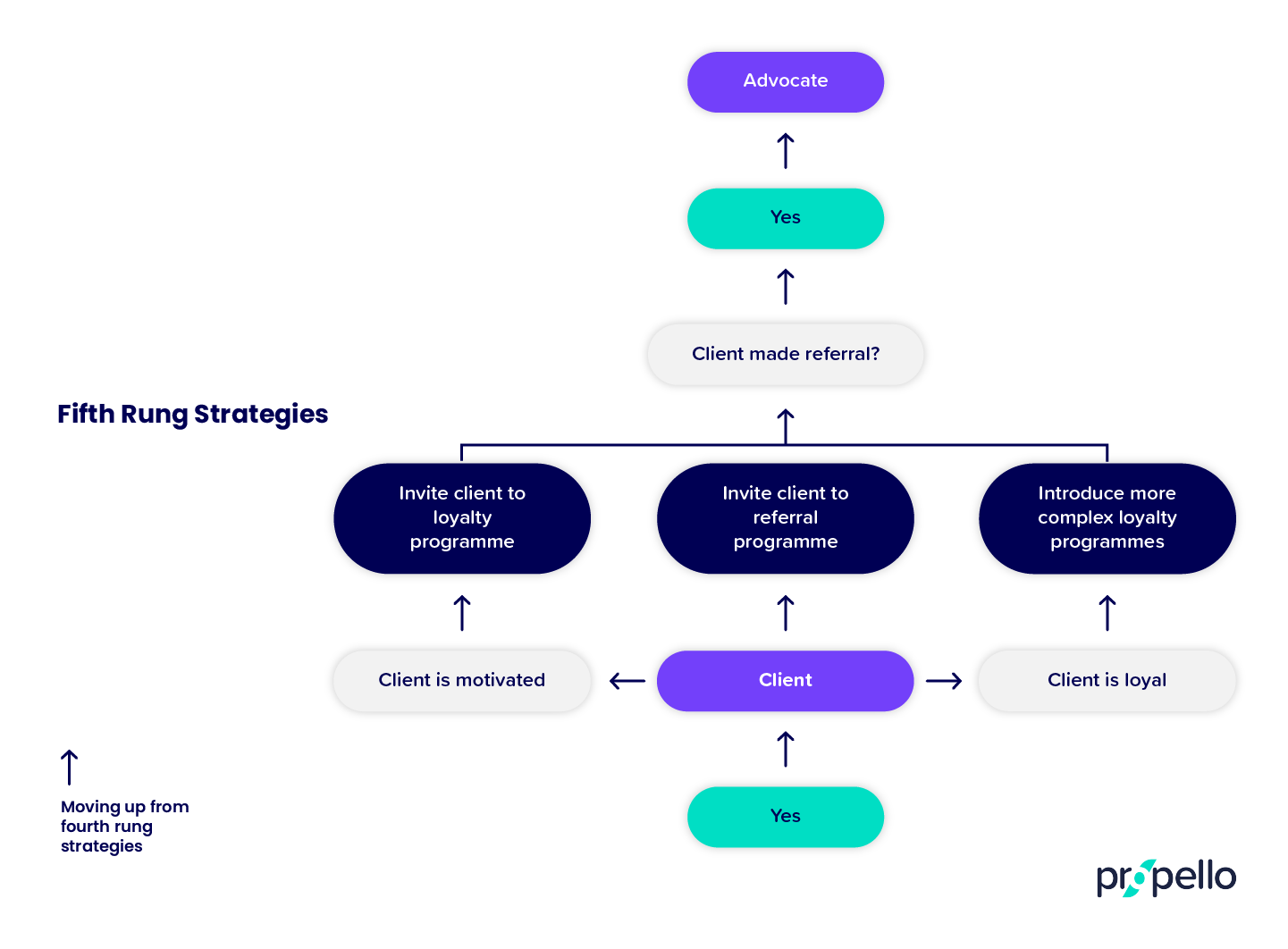
Final thoughts
Building a customer loyalty ladder isn’t just about keeping your customers—it’s about understanding them, guiding them, and ultimately turning them into brand champions. By recognising where each customer is on their journey and applying the right strategies at each stage, you can drive stronger engagement, increase lifetime value, and build a base of loyal advocates who fuel your growth.
But how are other brands tackling loyalty in 2025?
👉 Download our latest report, Loyalty Uncovered 2025 — a deep dive into the latest customer loyalty trends, strategies, and innovations shaping the industry right now. Learn what top-performing businesses are doing to retain, engage, and convert, and walk away with actionable insights to take your loyalty strategy to the next level.

FAQs
What is a customer loyalty ladder?
A customer loyalty ladder is a framework that segments customers based on their level of engagement and loyalty to a brand. It helps businesses understand the different stages of customer relationships, from leads to advocates, enabling targeted strategies to move customers up the ladder and foster long term loyalty.
Why is a customer loyalty ladder important for businesses?
A well-defined customer loyalty ladder provides a structured approach to building deeper, more meaningful relationships with customers. Businesses can create personalised experiences that drive retention, advocacy, and customer lifetime value while reducing acquisition costs.
How can businesses identify the different levels of their customer loyalty ladder?
Businesses identify different levels of their customer loyalty ladder by analysing customer behaviour, engagement, and transaction history. These include leads, prospects, customers, clients (repeat customers), and advocates. Defining clear criteria for each level helps businesses segment their customer base.
What strategies can businesses use to move customers up the loyalty ladder?
To move customers up the loyalty ladder, businesses should focus on delivering exceptional customer experiences, anticipating customer needs, and providing personalised interactions. Strategies include lead nurturing, seamless onboarding, post-purchase engagement, customer loyalty programmes and referral incentives.
How can businesses enhance the customer experience to build loyalty?
Enhancing the customer experience involves consistently delivering value, convenience, and personalisation across all touchpoints. Strategies include streamlining the buying process, providing excellent customer service, offering and creating engaging content. Customer feedback also plays a crucial role.
What role do loyalty programmes play in building customer loyalty?
Loyalty programmes are powerful tools for incentivising repeat purchases, encouraging higher spending, and fostering long term customer relationships. Tiered programmes that reward customers based on their loyalty level can be particularly effective.
How can businesses harness the power of brand advocates?
Businesses can harness the power of brand advocates by identifying their most loyal and enthusiastic customers and empowering them to spread positive word-of-mouth. Strategies include implementing referral programmes, showcasing user-generated content and actively engaging with advocates on social media.
How can businesses use customer feedback to improve their loyalty strategies?
Actively seeking feedback through surveys, reviews, and customer interactions, businesses can gain insights into customer preferences, pain points, and areas for improvement. Acting on this feedback demonstrates a commitment to customer satisfaction and helps businesses continuously refine their approach to loyalty.
What role does personalisation play in building customer loyalty?
Personalisation plays a crucial role in building customer loyalty by making customers feel valued, understood, and appreciated. Personalised experiences create a stronger emotional connection, increase engagement, and drive long term loyalty.
Author Bio, Written By:
Mark Camp | CEO & Founder at PropelloCloud.com | LinkedIn
Mark is the Founder and CEO of Propello Cloud, an innovative SaaS platform for loyalty and customer engagement. With over 20 years of marketing experience, he is passionate about helping brands boost retention and acquisition with scalable loyalty solutions.
Mark is an expert in loyalty and engagement strategy, having worked with major enterprise clients across industries to drive growth through rewards programmes. He leads Propello Cloud's mission to deliver versatile platforms that help organisations attract, engage and retain customers.

.png)

.png)